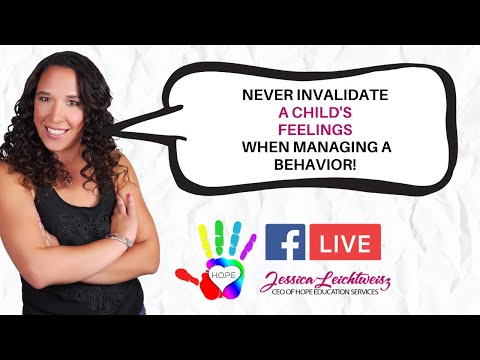This week ABA therapist Jessica Leichtweisz answers a question in sent in by one of our viewers. She discusses pairing and why it is important when starting ABA.
DISCLAIMER:
All information presented in this video is generalized and for education purposes only. It is not intended to treat, cure or prevent and disease and may not be applicable in every situation for every person.
Credits:
Video Recording and Editing by Nathan Bedford
Music from Kevin McCloud
Sound effects from Sound Bible
All images and sounds were taken from the public domain
References:
Cooper J.O, Heron T.E, Heward W.L. Applied behavior analysis (2nd ed.) Upper Saddle River, NJ: Pearson; 2007. <br> <h3>Auto Generated Captions</h3>
[Music]
[Applause]
hi and welcome back to hope education
asked an APA therapist parent training
series where you can ask me an ABA
therapists a question about ABA and I’ll
answer for you so it’s a nice question
is what is pairing and why is pairing so
important that’s a good question so
first of all pairing can have many many
different definitions in ABA but tonight
we’re going to talk a little bit about
pairing in the context of the time that
an ABA therapists takes to bond with a
child when they first start off in ABA
so as many people know when you’re doing
ABA you’re doing a lot of discrete trial
training and you’re working on a lot of
specific skills most parents are really
eager to get started
oftentimes you had a fight for services
and sometimes wait for services and so I
understand why you want to get started
right away
here’s the thing you know when you have
a child especially a child with special
needs there needs to be a period of time
where they bond with the therapist and
build rapport before you really start
getting into the work part of it so
oftentimes when you’re doing ABA a time
called pairing will occur where the
therapist will come and they’ll pair
themselves with fun activities the
purpose of that is so that when the
child sees a therapist coming in they’re
not crying they’re excited to see them
an eightieth therapist is working on
things that are really really hard for
children and anytime you’re you’re
changing behavior a lot of frustration
can occur on the part of the child in
that process so what you want to do is
make sure that the child and the
therapist have the best possible
relationship to ease some of that that
is then xiety that the children are
going to have and that that’s stress and
to make it much more fun pairing can be
a fast process and it can be a slow
process it really depends upon the child
whether they’ve received Sarah B before
their personality the age of the child
and really just how well the personality
the therapist in the child match
sometimes it can be accomplished in just
a few hours and then you know by the
second session you can really get going
and sometimes it can be a longer process
especially if a child has some sort of
anxiety so hang in there if your
therapist is asking to do pairing it’s a
really really good idea you know what
it’s going to do is make sure that your
child is set up for success and that
Foundation’s there if they’re are pissed
start working on things too quickly a
lot of times with wind up happening is
that that relationship never really
solidifies and you wind up needing to
get a new therapist and pull a therapist
off a case and that can waste even more
time because then you have to start the
process all over again
so pairing it’s a really important part
and it’s something that you want to make
sure you take enough time for so I hope
that answers your question about why
pairing is important and you know
whether or not it’s worth giving up part
of therapy in the beginning to make sure
it happens so if you have any questions
I can answer I’m happy to do so just
email me at Jessica Jessica likewise
calm I love to answer your questions
it’s a passion of mine to make sure that
parents have all the information they
need to give their children the best
possible treatment everyone in the globe
so god bless make it a great night and
check out our other videos at Facebook
and hope education to services god bless
make it a good night
[Music]
[Music]
you
Why do Pairing When Starting ABA? NC2duL0zfqc
[Music]
[Applause]
hi and welcome back to hope education
asked an APA therapist parent training
series where you can ask me an ABA
therapists a question about ABA and I’ll
answer for you so it’s a nice question
is what is pairing and why is pairing so
important that’s a good question so
first of all pairing can have many many
different definitions in ABA but tonight
we’re going to talk a little bit about
pairing in the context of the time that
an ABA therapists takes to bond with a
child when they first start off in ABA
so as many people know when you’re doing
ABA you’re doing a lot of discrete trial
training and you’re working on a lot of
specific skills most parents are really
eager to get started
oftentimes you had a fight for services
and sometimes wait for services and so I
understand why you want to get started
right away
here’s the thing you know when you have
a child especially a child with special
needs there needs to be a period of time
where they bond with the therapist and
build rapport before you really start
getting into the work part of it so
oftentimes when you’re doing ABA a time
called pairing will occur where the
therapist will come and they’ll pair
themselves with fun activities the
purpose of that is so that when the
child sees a therapist coming in they’re
not crying they’re excited to see them
an eightieth therapist is working on
things that are really really hard for
children and anytime you’re you’re
changing behavior a lot of frustration
can occur on the part of the child in
that process so what you want to do is
make sure that the child and the
therapist have the best possible
relationship to ease some of that that
is then xiety that the children are
going to have and that that’s stress and
to make it much more fun pairing can be
a fast process and it can be a slow
process it really depends upon the child
whether they’ve received Sarah B before
their personality the age of the child
and really just how well the personality
the therapist in the child match
sometimes it can be accomplished in just
a few hours and then you know by the
second session you can really get going
and sometimes it can be a longer process
especially if a child has some sort of
anxiety so hang in there if your
therapist is asking to do pairing it’s a
really really good idea you know what
it’s going to do is make sure that your
child is set up for success and that
Foundation’s there if they’re are pissed
start working on things too quickly a
lot of times with wind up happening is
that that relationship never really
solidifies and you wind up needing to
get a new therapist and pull a therapist
off a case and that can waste even more
time because then you have to start the
process all over again
so pairing it’s a really important part
and it’s something that you want to make
sure you take enough time for so I hope
that answers your question about why
pairing is important and you know
whether or not it’s worth giving up part
of therapy in the beginning to make sure
it happens so if you have any questions
I can answer I’m happy to do so just
email me at Jessica Jessica likewise
calm I love to answer your questions
it’s a passion of mine to make sure that
parents have all the information they
need to give their children the best
possible treatment everyone in the globe
so god bless make it a great night and
check out our other videos at Facebook
and hope education to services god bless
make it a good night
[Music]
[Music]
you
https://i.ytimg.com/vi/NC2duL0zfqc/hqdefault.jpg ABA,Autism,Applied Behavior Analysis,Applied Behaviour Analysis,Special Education,Hope Education Services,Jessica Leichtweisz This week ABA therapist Jessica Leichtweisz answers a question in sent in by one of our viewers. She discusses pairing and why it is important when starting ABA.
DISCLAIMER:
All information presented in this video is generalized and for education purposes only. It is not intended to treat, cure or prevent and disease and may not be applicable in every situation for every person.
Credits:
Video Recording and Editing by Nathan Bedford
Music from Kevin McCloud
Sound effects from Sound Bible
All images and sounds were taken from the public domain
References:
Cooper J.O, Heron T.E, Heward W.L. Applied behavior analysis (2nd ed.) Upper Saddle River, NJ: Pearson; 2007.



